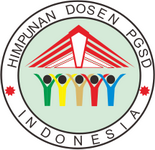The Effect Of Puzzle Media-Assisted Problem-Based Learning Model On Student Learning Outcomes
DOI:
https://doi.org/10.31949/jee.v7i4.13152Abstract
This study aims to examine the effectiveness of the Problem Based Learning (PBL) model integrated with puzzle media in improving the learning outcomes of first-grade elementary students in the subject of Civic Education (PKN), specifically on the topic of "Obeying Rules." The background of the study stems from the observation that students often have a weak understanding of discipline and compliance values due to teacher-centered learning approaches that lack active student involvement. This research employed a descriptive qualitative approach with data collection techniques including classroom observations, interviews, and document analysis. The findings revealed that implementing the PBL model supported by puzzle media significantly enhanced students’ learning outcomes, with an average score increase from 62 (pre-learning) to 87 (post-learning). Furthermore, the use of puzzle media successfully stimulated students' engagement, curiosity, and conceptual understanding through concrete and enjoyable visual representations. Both teachers and students responded positively to this model, as it encouraged active, collaborative learning aligned with the cognitive development stage of early-grade learners. This study contributes to the innovation of character-based Civic Education learning in primary schools and recommends the integration of active learning methods supported by visual media into the curriculum. Such an approach plays a vital role in shaping disciplined behavior from an early age and aligns with the goals of the "Profil Pelajar Pancasila" within Indonesia’s Merdeka Curriculum framework.
Keywords:
Problem Based Learning; , learning outcomes, obeying rules, Elementary School CivicsDownloads
References
Ariani, M., Nugraha, S., & Lestari, T. (2023). Problem Based Learning dalam meningkatkan kemampuan berpikir kritis siswa sekolah dasar. Jurnal Pendidikan Dasar, 10(2), 123–134. Https://Doi.Org/10.21009/Jpd.102.Ari.
Creswell, J. W., & Poth, C. N. (2021). Qualitative Inquiry and Research Design: Choosing Among Five Approaches. SAGE Publications. Https://Us.Sagepub.Com/En-Us/Nam/Qualitative-Inquiry-and-Research-Design/Book246896.
Ertmer, P. A. (2025). Teacher pedagogical beliefs: The final frontier in our quest for technology integration? Educational Technology Research and Development, 53(4), 25–39. https://doi.org/10.1007/BF02504683
Faizmailiatus Sofa, & Reza Ayu Nur Safitri. (2022). Pemikiran Pragmatisme-Konstruktivisme John Dewey sebagai Metode Pembelajaran di Madrasah Tsanawiyyah. HEUTAGOGIA: Journal of Islamic Education, 2(1), 45–62. https://doi.org/10.14421/hjie.2022.21-04
Gunawan, I. (2021). Triangulasi dalam penelitian kualitatif: Teknik validasi data. Jurnal Pendidikan Dan Kajian Ilmu, 4(1), 16–22. Https://Ejournal.Unib.Ac.Id/Index.Php/Jpkilmu/Article/View/13490.
Kemdikbudristek. (2023). Profil Pelajar Pancasila dan transformasi pembelajaran. Jakarta: Kemdikbudristek. Https://Pusatinformasi.Kemdikbud.Go.Id.
Kristanto, A. (2024). Students ’ Perception of a Blended Project Based - Learning to Promote Critical Thinking. https://doi.org/10.2991/978-2-38476-301-6
Lestari, H., & Pramudya, A. (2022). Observasi dalam penelitian pendidikan dasar. Jurnal Penelitian Pendidikan Dasar, 8(1), 34–41. Https://Ejournal.Unesa.Ac.Id/Index.Php/Pgsd/Article/View/45128.
Miles, M. B., Huberman, A. M., & Saldaña, J. (2020). Qualitative Data Analysis: A Methods Sourcebook (4th ed.). SAGE Publications. https://us.sagepub.com/en-us/nam/qualitative-data-analysis/book246128. SAGE Publications. Https://Us.Sagepub.Com/En-Us/Nam/Qualitative-Data-Analysis/Book246128.
Moleong, L. J. (2021). Metodologi Penelitian Kualitatif (Edisi Revisi). Bandung: Remaja Rosdakarya.
Nengsih, S., Haryanti, Y. D., & Yonanda, D. A. (2024). Optimalisasi Penggunaan Media Pembelajaran untuk Memahami Sistem Pencernaan Manusia pada Tingkat Sekolah Dasar. Sekolah Dasar: Sebuah Kajian Teori Dan Praktik Pendidikan, 33(1), 49-58.
Putri, N. K., & Susanti, Y. (2023). Efektivitas media puzzle dalam meningkatkan hasil belajar siswa kelas rendah. Edukatif: Jurnal Ilmu Pendidikan, 3(5), 2305–2313. https://edukatif.org/index.php/edukatif/article/view/846. Jurnal Ilmu Pendidikan, 3(5), 2305–2313. Https://Edukatif.Org/Index.Php/Edukatif/Article/View/846.
Ridzky Iklasul Fariasih, & Achmad Fathoni. (2022). Project Based Learning Model on Motivation and Learning Outcomes of Elementary Civic Education. Jurnal Ilmiah Sekolah Dasar, 6(4), 705–711. https://doi.org/10.23887/jisd.v6i4.55782
Setıana, D. S., & Nuryad. (2020). Kajıan Kurıkulum Sekolah Dasar Dan Menengah. Gramasurya.
Sugiyono. (2020). Metode Penelitian Kualitatif, Kuantitatif, dan R&D. Bandung: Alfabeta.
Suryani, D. (2022). Penggunaan pendekatan kualitatif deskriptif dalam pendidikan dasar. Jurnal Edukatif, 6(2), 115–122. Https://Edukatif.Org/Index.Php/Edukatif/Article/View/1034.
Yonanda, D. A., Supriatna, N., Hakam, K. A., & Sopandi, W. (2022). Kebutuhan bahan ajar berbasis kearifan lokal Indramayu untuk menumbuhkan ekoliterasi pada siswa sekolah dasar. Jurnal Cakrawala Pendas, 8(1), 173-185.
Yulianti, D., & Prabowo, B. (2023). Efektivitas PBL terhadap hasil belajar dan karakter siswa. Jurnal Pendidikan Humaniora, 11(1), 77–85. Https://Journal.Um.Ac.Id/Index.Php/Jph.












